Heian Jingu Shrine in Kyoto: Highlights and History

Heian Jingu Shrine is located in Kyoto's Okazaki Park, one of the city's prominent cherry blossom spots. We introduce the history of this shrine and its highlights.
Explore the Heian Jingu Shrine in Kyoto
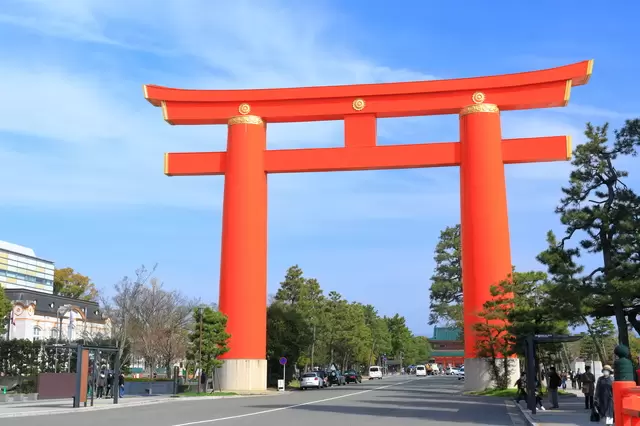
Heian Jingu Shrine is located in Okazaki Park, which is also home to the National Museum of Modern Art, the Kyoto Municipal Zoo, and many other attractions. This area is rich in culture, offering a variety of places to enjoy, and overall, it is a great spot for sightseeing.
In one corner of Okazaki Park, there is a giant red torii (shrine gate) that rises above as if it were reaching for the sky.
A torii marks the entrance to sacred grounds at a shrine. However, around this torii, there are no other buildings that appear to be part of a shrine. Believe it or not, this torii actually denotes the entrance to Heian Jingu Shrine.
In this article, we introduce the history and highlights of Heian Jingu Shrine.
The Precincts of Heian Jingu Shrine
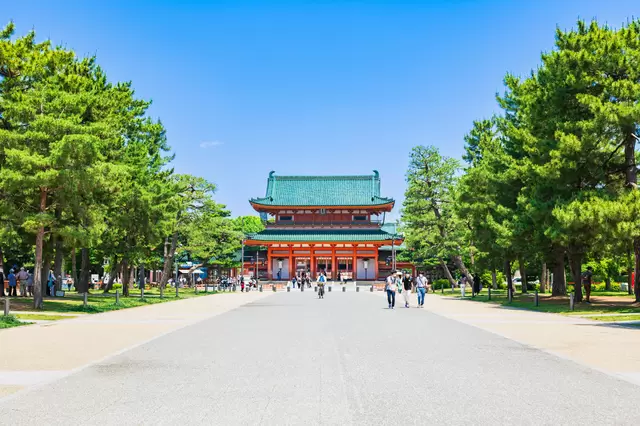
At the end of the road that passes through the torii, you can faintly see a Japanese-style building. This building is the otemon, or the entrance to Heian Jingu.
Once you pass through the otemon, you’ll be on the sando, the path that leads up to the shrine. As you walk down this road, you’ll have a clearer view of the shrine and get a sense of just how big Heian Jingu is.
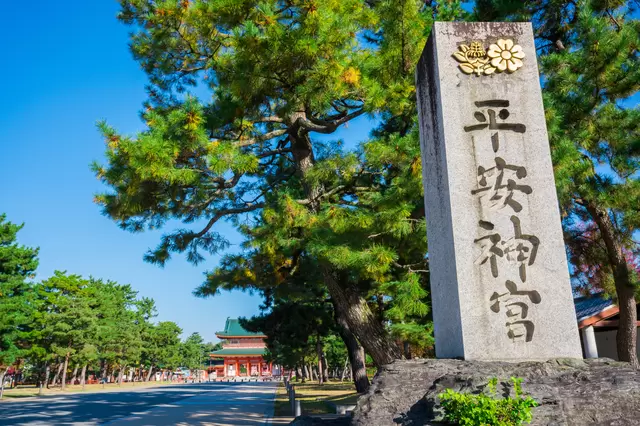
When you’ve made it this close, you’ll finally be able to see a stone pillar with the Japanese characters reading 'Heian Jingu' (Heian Shrine) carved into it.
A Shrine Dedicated to an Ancient Emperor
Heian Jingu Shrine was built in 1895, which, compared to other temples and shrines in Kyoto, makes it relatively new. It is dedicated to Emperor Kanmu, who is remembered for making Kyoto the capital of Japan.
In addition, Emperor Komei, who was the last emperor to reign in Kyoto, is also enshrined here. The home of the current reigning imperial family is in Tokyo.
While we’re on the subject, in addition to the buildings here, the outer grounds have all been restored to the original state they were in when Kyoto became the capital of Japan back in 794. The shrine is only 5/8 the size it originally was, but here you can take in the over 1200-year-old atmosphere of Kyoto.
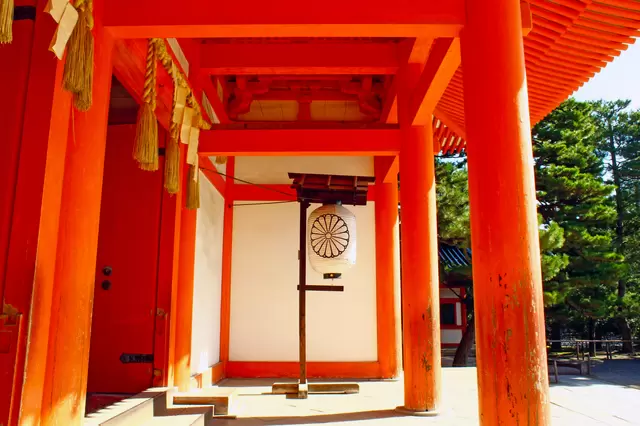
Because this shrine is dedicated to past emperors, you'll find the chrysanthemum family crest throughout the area, as it represents the Imperial family.
This picture features a traditional Japanese paper lantern adorned with the chrysanthemum crest. This crest can be seen all over Heian Jingu Shrine, so when you visit, be sure to look around for more of them.
Feel the Charm and Beauty of Kyoto at the Outer Shrine
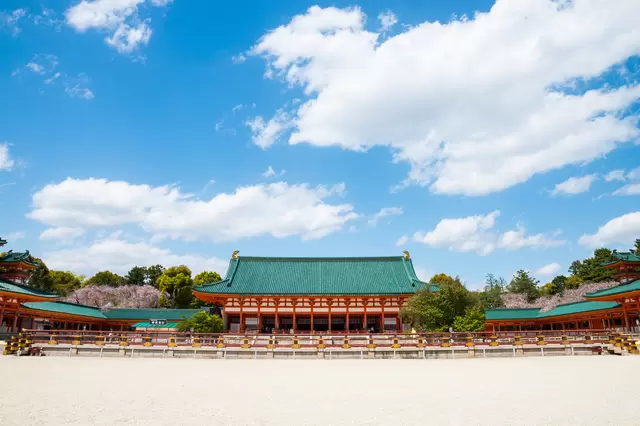
When you pass through the Otemon gate, you’ll enter an area where fine white gravel has been laid out.
The building you see in the middle of the photo above is known as the gaihaiden (outer shrine). Like other temples and shrines, this building is where you make a small offering of money to a god before praying.
The gaihaiden is modeled after the daigokuden, the council hall of the imperial palace located in the outer grounds. The daigokuden is the building where significant events, such as the enthronement of the emperor, and various political ceremonies took place.
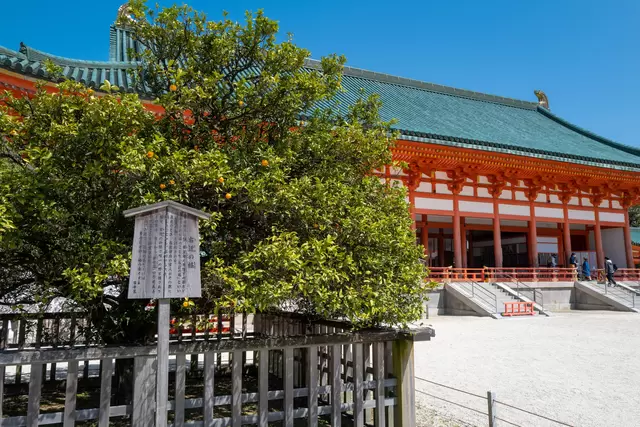
The ukon-no-tachibana tree
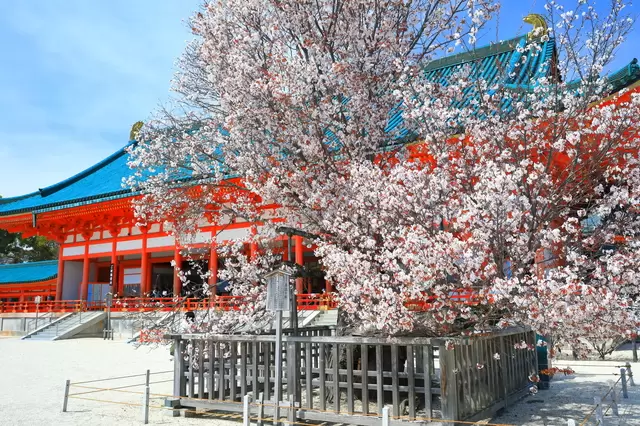
The sakon-no-sakura tree
On the sides of the outer shrine are two trees that protect it. When viewing the outer shrine from the Otemon gate, you’ll see the ukon-no-tachibana tree on the left and the sakon-no-sakura tree on the right.
These trees, planted at Heian Shrine, share names with those that once grew in the former outer grounds. Even today, people come to admire the cherry blossoms when they bloom here in the spring. Remarkably, these cherry trees have been cherished by the Japanese for over 1,200 years.
A tachibana tree produces a type of citrus fruit similar to a small orange. Long ago, this citrus fruit was believed to have medicinal properties, being associated with perpetual youth and longevity.
Heian Jingu's Sacred Garden

After visiting the outer shrine, why not explore the Heian Shrine Sacred Garden that surrounds its perimeter?
The Heian Shrine Sacred Garden is a Japanese garden that covers an area of approximately 33,000 square meters.
In spring, you can enjoy the cherry blossoms; in summer, the Japanese irises; in autumn, the changing colors of the leaves; and in winter, a beautiful snowy landscape.
Jidai Matsuri: An Important Annual Festival in October
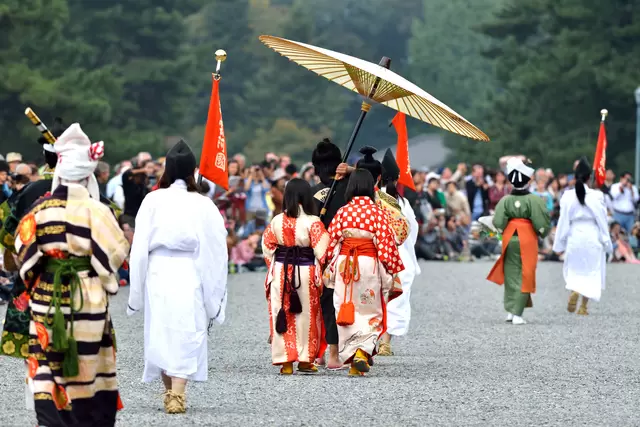
One of the three biggest festivals in Kyoto is the Jidai Festival, which takes place at Heian Jingu Shrine.
"Jidai" means "era" in Japanese. The festival is exactly as its name suggests; it is an event where you can experience the history of Kyoto and its various eras in just one day.
The festival occurs every year from October 15th to 23rd, with the most anticipated event being the parade on October 22.
On this day, participants wear clothing from different periods in Japanese history, forming a line and walking in procession throughout Kyoto. They start at Kyoto’s Imperial Palace (the former residence of the emperor) and make their way to Heian Jingu Shrine.
This is the perfect opportunity to closely experience both Japanese clothing and culture. For those visiting Heian Jingu in October, it is a must-see event.
Exjoy Exploring Heian Jingu Shrine
Heian Jingu is a fantastic place to experience the atmosphere of Japanese tradition fully.
In addition to the Heian Shrine's Sacred Garden, there is also a zoo, an art museum, and other attractions nearby, making it easy to enjoy some sightseeing in Kyoto centered around Heian Jingu Shrine without needing to travel far. For those of you who are interested in Heian Shrine, I highly recommend paying it a visit.
Hotels near Heian Shrine
All photos by PIXTA
MATCHAで編集やってます植松です。87世代。






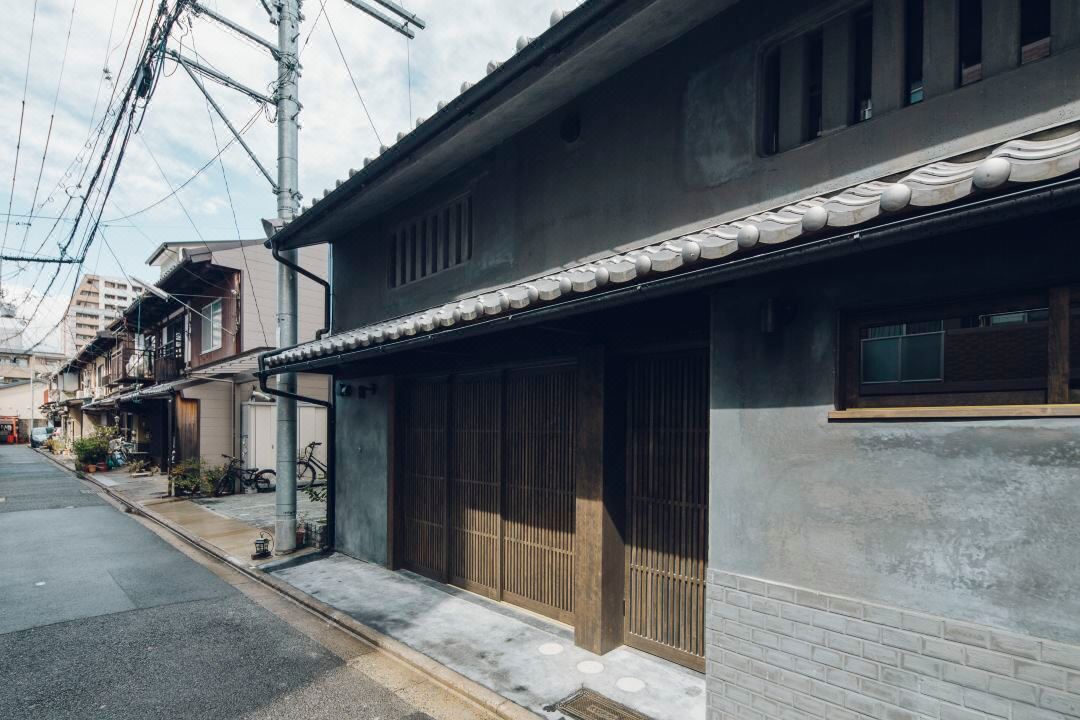

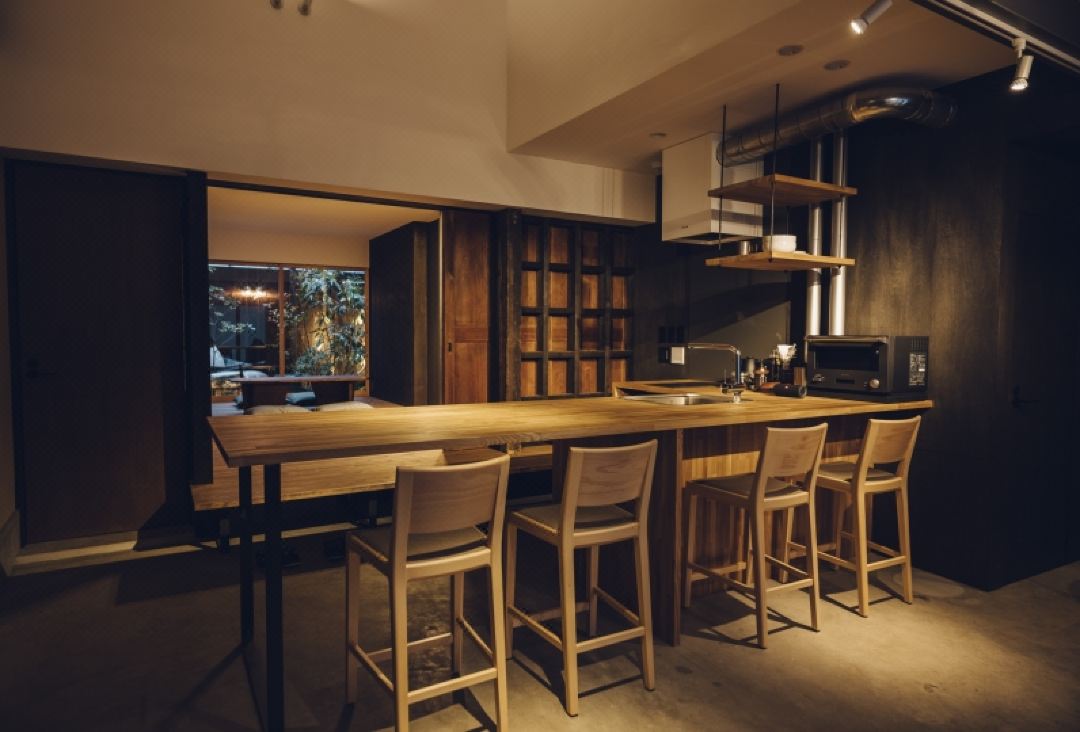
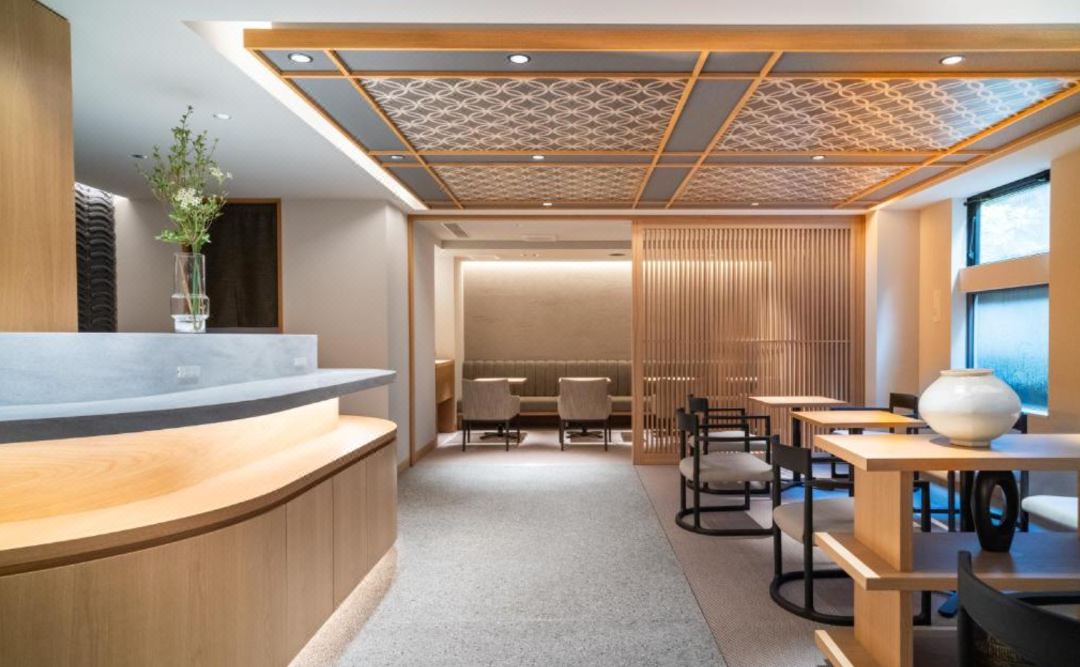






































![[Coupon Available] Attention Overseas Winter Sports Fans! Nagano's Sports Depot Has Evolved](https://resources.matcha-jp.com/resize/720x2000/2026/01/05-254819.webp)
![[2 hours from Tokyo ] 10 Quiet and Breathtaking Views of Mount Fuji in Yamanashi Hokuto City , Yamanashi - Part 2](https://resources.matcha-jp.com/resize/720x2000/2025/12/16-253037.webp)

![[Reopening in March 2026] Ikoma Sanjo Amusement Park Park, 45 minutes from Osaka , with free admission](https://resources.matcha-jp.com/resize/720x2000/2024/08/28-194409.webp)